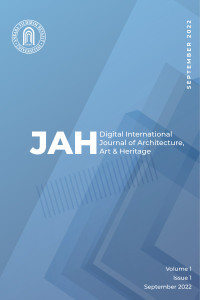Heritage of Arabic Geometry: Al–Samarqandī’s Work in Fundamental Geometric Theorems
Heritage of Arabic Geometry: Al–Samarqandī’s Work in Fundamental Geometric Theorems
The manuscripts of Arabic scientific heritage are full of invaluable knowledge which was lost or neglected even by Arabic speaking scholars. Moreover, the authors of the available manuscripts were not studied enough by Arab scholars even though their work had established the basics of different modern sciences, beside the fact that methods and terminologies used in Arabic manuscripts are still used today.
In this paper we shed light on the work of one of the founders of the science of geometry in the Arab heritage, Shams al‐Samarqandī , namely Ashkāl al-Tā’sīs, which is translated into English as Fundamental Theorems, that is considered as one of the early writing, in which different basic geometric propositions and their properties are explained.
By studying and analysing the information he presented, we try to show the importance of his work, demonstrating some salient examples that present the paramount quality of al–Samarqandī’s work for the Arab heritage of geometry.
Discussing his methodology and comparing it with the scientific facts established nowadays in geometry, the results show, that he was a pioneer scholar and mathematician of the scientific heritage written in Arabic whose work should be studied more carefully and thoroughly to understand his influence on the science of geometry with a manuscript of less than thirty pages, forming the current used terms nowadays in Arabic geometry. Finally, the conclusions and results suggest some recommendations to preserve and Present the rich scientific heritage written in Arabic.
Keywords:
Geometry, Arabic mathematical heritage, geometrical theorems or propositions al–Samarqandī,
___
- Bağdadlı, İ. P. (1955). Hadiyyat al‐ʿārifīn [Gift of the wise]. Milli Egitim Bakanligie Yayinleri.
- Bingöl, A. (1991). Shams al‐Din Muhammad b. Ashraf Al-Samarqandi ve Qistas al‐Afkar'ı [Shams al-Din Muhammad b. Ashraf Al-Samarqandi and Qistas al-Afkar]. Edebiyat Bilimleri Arastırma Dergisi, 19, 173–182.
- Brockelmann, C. (1943). Geschichte der arabischen Litteratur [History of Arabic literature] (2nd ed., Vol. 1). Brill.
- Dilgan, H. (1960). Démonstration du Ve postulat d'Euclide par Shams‐ed‐Din Samarqandi [Demonstration of Euclid's fifth postulate by Shams-ed-Din Samarqandi]. Revue d'histoire des sciences et de leurs applications, 13, 191–196.
- Dilgan, H. (1980). Qāḍī Zāda al-Rūmī. In Dictionary of Scientific Biography (Vol. 11, pp. 227–229).
- Ihsanoğlu, E. (2004). The Madrasas of the Ottoman Empire. FSTC Limited.
- Fazlıoğlu, İ. (2007). Samarqandī: Shams al‐Dīn Muḥammad ibn Ashraf al‐Ḥusaynī al‐Samarqandī [Samarqandi: Shams al-Din Muhammad ibn Ashraf al-Husayni al-Samarqandi]. In T. Hockey et al. (Eds.), The Biographical Encyclopedia of Astronomers (Vol. 2, p. 1008).
- Fazlıoğlu, İ. (2008). The Samarqand Mathematical-Astronomical School: A Basis for Ottoman Philosophy and Science) debate that the actual meaning is basic forms of the existent. J.H.A.S., 14, 3–68. Herz-Fischler, R. (1987). A Mathematical History of Division in Extreme and Mean Ratio. Wilfrid Laurier University.
- Čelebī, K. (1941). Kashf al‐ẓunūn ʿan asāmī al‐kutub wa‐ʾl‐funūn [Removal of doubts about the names of books and sciences] (Vol. 1). Milli Egitim Bakanligie Yayinleri.
- De Young, G. (2001). The Ashkāl al-Ta’sīs of al-Samarqandī: A Translation and Study. Zeitschrift für Geschichte der Arabisch-Islamischen Wissenschaften, 14, 57–117.
- Al‐Samarqandī, S. (1985). Al‐Ṣaḥaʾif al‐ilāhiyya [The divine pages] (Vol. 1). Moktabaṯ al‐Fatāḥ.
- Souissi, M. (1984). Ashkāl al‐Taʾsīs li‐ʾl‐Samarqandī: with the Sharḥ of Qāḍīzāde al‐Rūmī [The foundations of geometry according to al-Samarqandi.
- Al-Zirikli, K. (1926). Al-Aʻlām [In Arabic], Vol.6, 39–42. Egypt: Arabic Printer.
- URL-1. Wikisource. (2019). Ashkāl al-Tā’asīs [In Arabic]. Egyptian Book Library. Retrieved April 5, 2019, from https://ar.wikisource.org/wiki/%D9%85%D9%84%D9%81:%D8%A3%D8%B4%D9%83%D8%A7%D9%84_%D8%A7%D9%84%D8%AA%D8%A3%D8%B3%D9%8A%D8%B3_%D9%81%D9%8A_%D8%A7%D9%84%D9%87%D9%86%D8%AF%D8%B3%D8%A9_%D8%AE.pdf
- Başlangıç: 2022
- Yayıncı: Ankara Yıldırım Beyazıt Üniversitesi
